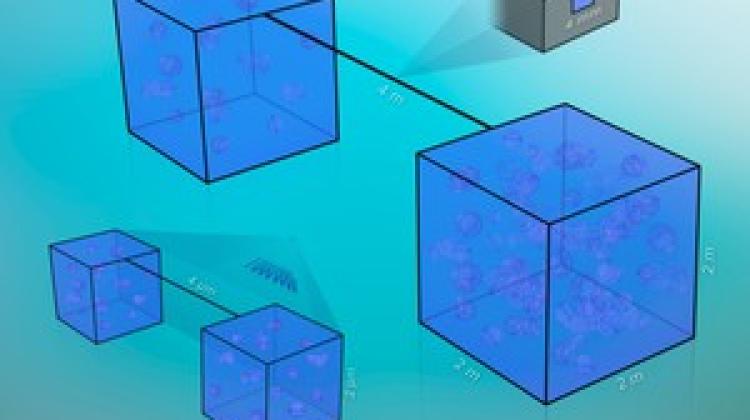Liquids in micro reservoirs can communicate over long distances
 If you connect large reservoirs with very narrow and long channels, the liquid in each container will behave independently of the liquid in the other tank. But different physics works in the microworld: if the liquid filling the containers meets certain conditions (the most important of which is the condition of the coexistence between the two phases), even surprisingly small channels can correlate the states of liquid in neighbouring reservoirs. Source: Institute of Physical Chemistry PAS
If you connect large reservoirs with very narrow and long channels, the liquid in each container will behave independently of the liquid in the other tank. But different physics works in the microworld: if the liquid filling the containers meets certain conditions (the most important of which is the condition of the coexistence between the two phases), even surprisingly small channels can correlate the states of liquid in neighbouring reservoirs. Source: Institute of Physical Chemistry PAS
Yet another proof that the world is on a scale of cells works differently than the macro scale world! Microreservoirs connected with extremely thin channels exhibit collective behaviour, although it would seem that the communication between them is impossible. Researchers, including a Polish scientist, showed that this effect is more common than previously thought.
Mysterious "action at a distance" has been discovered recently. Until now it was only observed in helium cooled to very low temperatures. However, the theoretical model of the phenomenon - developed by an international team of scientists, including researchers from the Institute of Physical Chemistry of the Polish Academy of Sciences in Warsaw - suggests that the correlation between the reservoirs may also occur in other liquids and in much more typical conditions.
"You can imagine that this effect could also be important in biological systems" - noted in an interview with PAP study participant, Dr. Anna Maciołek of the Institute of Physical Chemistry PAS and the Max-Planck-Institut fuer Intelligente Systeme and the University of Stuttgart.
Institute of Physical Chemistry PAS reported in the release sent to PAP that the first report of the "action at a distance" between reservoirs of liquid was published in 2010 by US researchers. They created an array of tens of millions of hollows for liquid helium on a silicon plat, connected with narrow channels. Dr. Maciołek explained what the experiment would look like when magnified a million times. "Let\'s change the scale for a moment and imagine cubic containers, each with a side of two metres. Each pair of containers is connected by a tube four metres long with a diameter of three millimetres. According to existing theories, such a small channel should not synchronize the phenomena occurring in the containers. And yet, in the microworld it does!" - she said.
The research results showed that the properties of helium in a tank depended on what was happening in the adjacent reservoirs. "Imagine that you cause a local disturbance in one of the containers. It turns out that this local disturbance is felt in the other, even very distant containers, although the connection between them is really tiny. However, the correlation between the containers disappears very, very slowly" - Maciołek admitted. Helium cooled to a very low temperature, apparently divided into millions of independent reservoirs, was inexplicably acting as if it was still a physical whole.
Initially it seemed that this effect resulted from quantum phenomena that occur only in specific, difficult-to-obtain conditions - e.g. in superfluid helium (one of the properties of superfluid helium - formed at temperatures close to absolute zero - is the complete absence of viscosity). However, Dr. Maciołek’s theory, confirmed by computer simulations, proves that the effect of "action at a distance" does not require extreme conditions and can also occur in classical one-component fluids and in mixtures.
For the phenomenon to occur, in the original experiment the liquid helium needed to be at a state close to the appearance (or disappearance) of superfluidity. For other fluids, low temperatures are not needed. Simulations have shown, for example, that the phenomenon of communication may also occur in the case of model mixtures: water and lutidine - an oily liquid. These substances mix only in a certain range of temperatures and the communication between the reservoirs only appears within this range. Scientists interpret that the most important requirement is the existence of phase transition and the associated state in which two different forms (phases) of a liquid may occur simultaneously. Also important are the dimensions of the reservoirs and the connecting channels: the phenomenon ceases to exist when the distances are significantly larger than the size of human cells.
"In biological systems there are naturally occurring fluids that could meet the conditions, which we described" - the researcher told PAP and gave the example of cell membranes. Perhaps the conditions prevailing in the cell membrane could be sufficient to obtain the effect of correlation between seemingly independent elements.
For now it is known that the study results can be used, for example, in microfluidic systems. Systems of this type are built to carry out chemical or biological experiments in individual droplets. "You should be aware that in certain situations the communication between the vessels may occur and it may have an impact on the experiment - sometimes desirable, and sometimes not" - concluded Dr. Maciołek.
The study results were presented in the August issue of the "Physical Review Letters".
PAP - Science and Scholarship in Poland
lt/ agt/ mrt/
tr. RL
Przed dodaniem komentarza prosimy o zapoznanie z Regulaminem forum serwisu Nauka w Polsce.

















